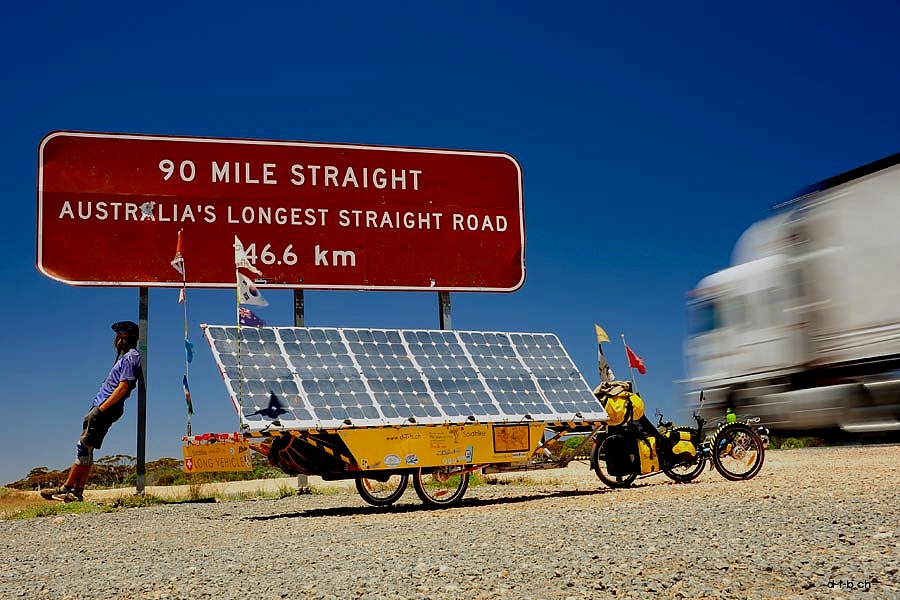
Introduction
After my first attempt failed miserably (two broken axles within the first 500 km), I decided to abandon the idea of some kind of rickshaw and found Honza and Karel from the Czech Solar Team that rode the SunTrip 2013. They had over 7000km of experience and after brain-storming together they built me my Solatrike version 2 from an AZUB T-Tris. Because I don’t race, but wanted to do a world tour, we adjusted everything according to my needs and chose a long trailer for all the luggage and solar panels.
By chance, I met Joachim from SolarFun in Germany, who made flexible solar panels that fit the dimensions of my trailer exactly. For the motorisation, we took over the hub motor that was already with the SunTrip.
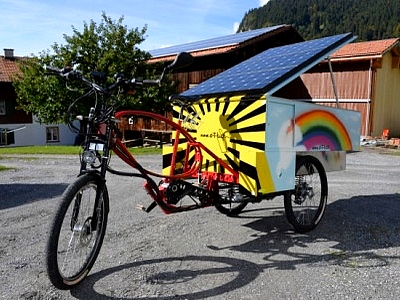
However, because my luggage is heavy and in order to get up the hill slowly, we chose an additional mid-drive motor, which is connected to the crankset via an additional chain. This supports me from 4-8km/h because the hub motor does not run below 10 km/h.
In July 2015, I set off to ride as far and as long as possible. After 5 self-supported years through 22 countries, 3 continents, 40’000km, two new trailers, some replaced motors, replaced solar panels, two new batteries and many repairs carried out on the road, the trip came to an indefinite pause in New Zealand due to the pandemic. But anyway, I’m already going with Blaise Pascal’s motto: “If you want to make God laugh, tell him your plans.”
Detailed technical presentation
The trike
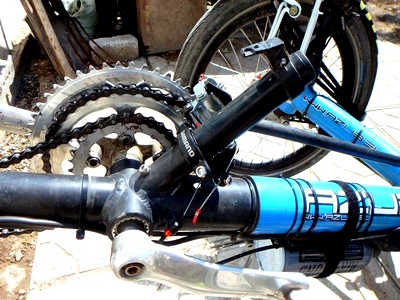
- AZUB T-Tris 20 non suspended, non-foldable. (A folding trike makes no sense with a 4m long trailer).
- All wheels 20”
- Hubmotor: 10 – 25 km/h
- Mid-Drive-motor: about 4 – 8 km/h
- Highest speed until now (downhill without motor of course): 65.75 km/h
- Gear: Shimano Altus 6 Gear (14-34) with 8 Gear-chain
- Cruise Control, (Backwards gear only 1st motor)
- Brakes: Sturmey Archer drum brakes
- Tires: Schwalbe Marathon Plus 47 – 406 20 x 1.75 (Pressure: 5.0Bar)
- 2 Front lights: 48Volt attached to the battery
- The Mid-Drive-motor is attached with a single-chain.
- Crankset with 3 chainrings
- Battery mounted above the rear wheel
- One bottle holder
- 3 rear mirrors
- One bike bell, one bike horn and an AirZound-bike-horn
- Shimano Tourney SL-TZ20-6 Speed Thumb shifters
- 5 Ortlieb bags
- One waterproof bag for the phone. Charging cable attached to a small extra solar panel on the trailer.
The motorization
1st Hub motor – until June 2018
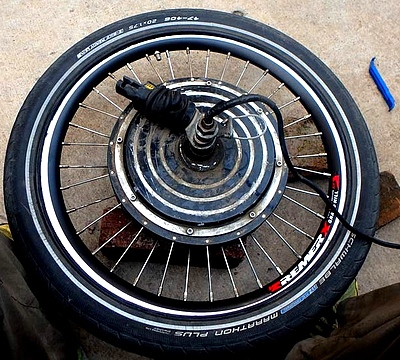
The first hub motor is of unknown origin, I don’t have the exact data.
2nd Hub motor – since June 2018 – by Electroride
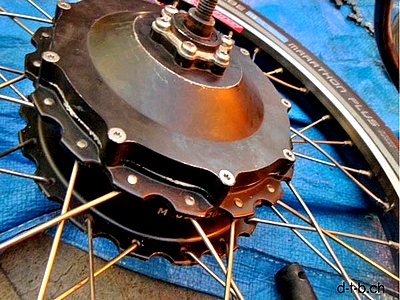
- ENDURO TM Planetary Gear Drive
- 10T Torque Motor (9.5lbs)
- Throttle: Thumb Throttle
- Wheel Build: 20” 24mm wide Alex TM DM218 Silver
- Torque Arm: Rear Rev4 Version (1pc)
- Programming Cable
- Cruise control: optional
- Motor diameter: 7.5″
- Motor weight: 4.3 kg
1st Mid Drive Motor – June 2015 -> June 2018 – by Mid Drive Ebike
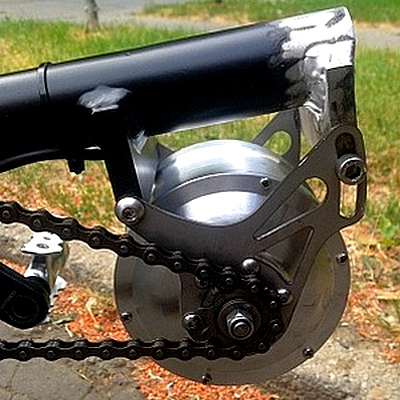
- 48V brushless gearless with hall sensors (no more in production)
- Reduction system: Internal planetary gearbox
- Average current: 4A
- Throttle control: Hall sensor
- Internal BB width: 68mm
- Weight: 3.6 kg
- This motor was dismantled and is no more in usage.
2nd. Mid Drive Motor – June 2018 -> September 2019 – by GNG Electric, Hong Kong
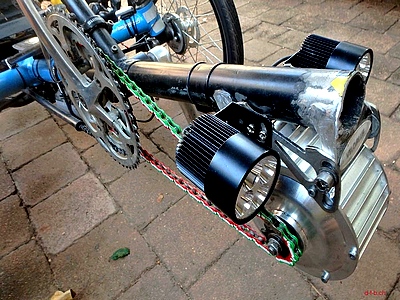
- Model: GNG GEN2 Motor brushless gearless with hall sensors (no more in production)
- Reduction system: Internal planetary gearbox
- Rated speed: RPM: 3000
- Rated torque: Oz-in: 38 Nm: 0.26
- Rated current: A: 5.5
- Peak torque: Oz-in: 110 Nm: 0.8
- Peak current: A: 15
- This motor was dismantled and is no more in usage.
3rd. Mid Drive Motor – since October 2019 – by Cyclone
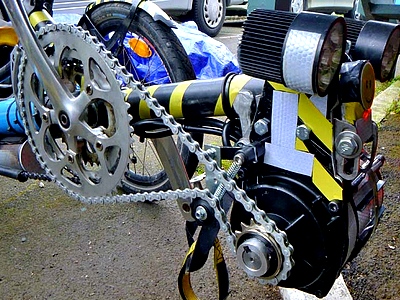
- Motor brushless and gearless with Hall sensors.
- Reduction system: internal planetary gear
- Max. Speed 900 rpm.
- Rated speed 800 rpm.
- Rated output 3200W (reduced to 200W)
- (Max. output 4500W)
- Rated torque 70Nm
- Max. Torque 130Nm
- Rated current 45A (reduced to 5.5A)
- Insulation class E-Class
- Driver: External driver
- Control method PWM
- Ambient temperature -15C~40C
- Efficiency: 97.6%.
- Weight 5Kg
Old Cycle Analyst for measure the Voltage of the battery and how many Watts used.
The battery
1st Battery by E-POHONY Šikula s.r.o. CZ
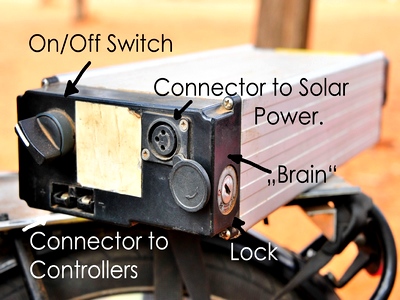
- Li-ion – 48V / 17.6Ah
- 13 ICR18650-8
- Nominal Voltage: 48V
- Nominal capacity: 17.6 Ah – 844.8 Wh
- Nominal discharge current: 35 A
- Maximum discharge current: (5s) 105A
- Maximum charging current: 5A
- Charging Voltage: 54.6V
- Weight: 6.7 kg
- BMS (The “Brain”) included
2nd Battery since Feb. 2019 made by Mic Chapman of Micycles Adelaide AUS
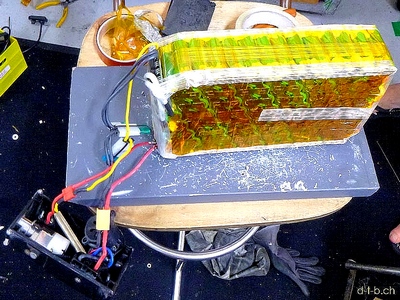
- Capacity: 10 – 20Ah
- Voltage: 48v
- Type: Lithium Battery (Li-ion)
- Nominal Capacity (Ah): 20Ah
- Nominal Voltage (V): 48V
- Cell Specification: 3.7V 2.6Ah 18650
- Cell Combination: 8 parallel with 13 series
- Cell Quantity (parallel*series): 104 pcs
- Discharge Cutoff Voltage (V): 30+/- 1V
- Charge Cutoff Voltage (V): 42V
- Rated Discharge Current (A): 30A
- Charge Mode: CC/CV
- Standard Charge Current (A): 2A
- Weight: 6.2 kg
- BMS (The “Brain”) included
Solar Equipment and/or Solar Trailer
Trailer I : Made in Uherský Brod, Czech Republic by AZUB
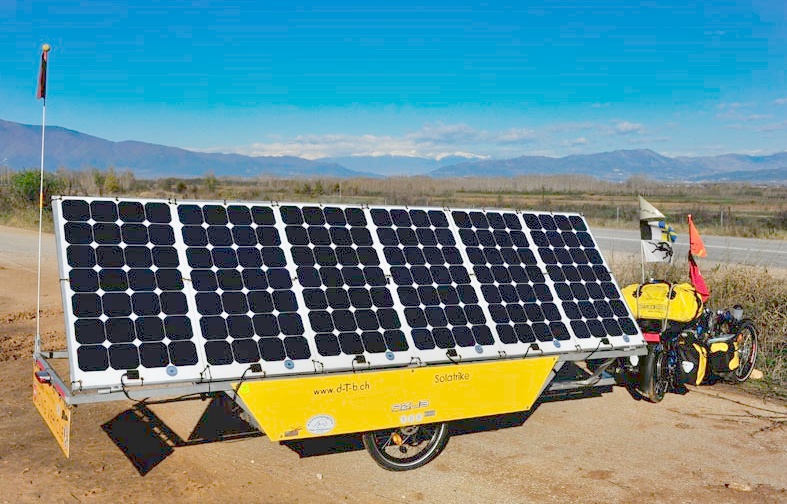
- Width: 100cm
- Height at the back 58cm, at the front 53.5cm
- Height with the standing Panel: 147cm
- Height with flag: 209cm
- Length: 407cm
- Weight without luggage: 42 kg
- Weight with luggage: 100 kg
- Total weight with Trike: 161 kg
- Total weight with driver: approx. 235 kg (But the weight of the luggage varies with the transported food and the weight of the driver varies as well.)
- Total length with the Trike: 563cm
- Sturmey Archer drum brakes
- Schwalbe Marathon Plus Tires 47 – 406 20 x 1.75 (Pressure: 5.0Bar)
- This Trailer was dismantled and left in Mashhad, Iran.
Trailer II : Made in Tashkent, Uzbekistan at Akfa
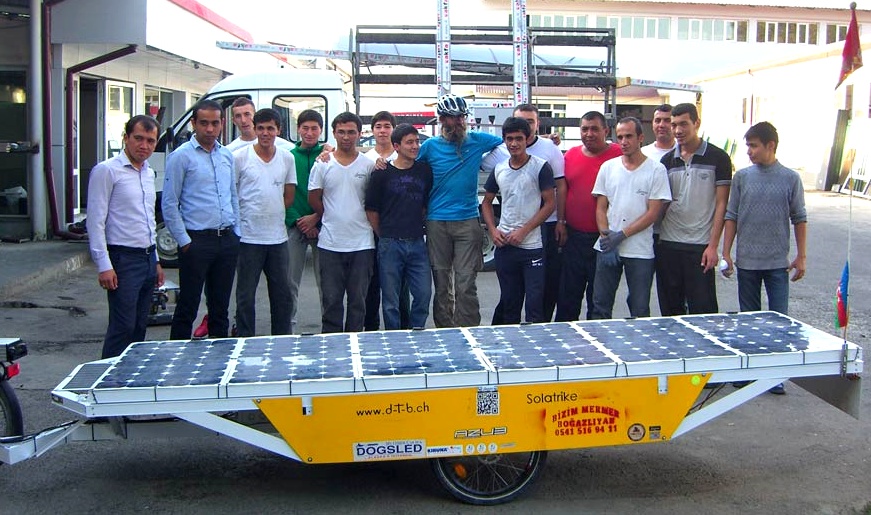
- Width: 99 cm
- Height at the back 69cm, at the front 52cm
- Height with the standing Panel: 155cm
- Height with flag: 219cm
- Length: 380 cm
- Weight without luggage: 46 kg
- Weight with luggage: 90 – 100kg
- Total length with the Trike: 560 cm
- Sturmey Archer drum brakes
- Schwalbe Marathon Plus Tires 47 – 406 20 x 1.75 (Pressure: 5.0Bar)
- This Trailer was dismantled and thrown away in Hong Kong.
Trailer III : Made in Darwin, Australia at Darwin Metal Industries
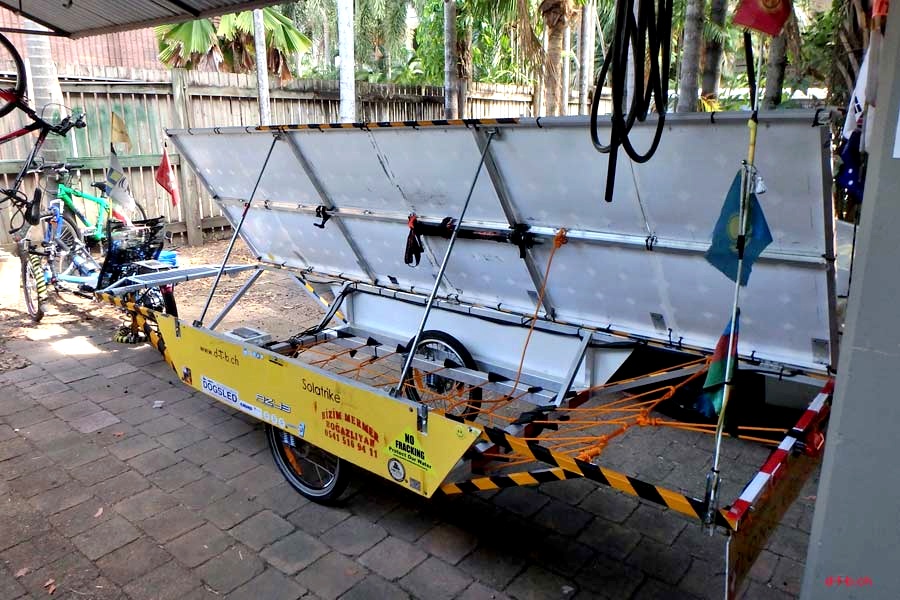
- Width: 99 cm
- Height at the back 71.5cm, at the front 59.2cm
- Height with the standing Panel: about 140cm
- Height with flag: 219cm
- Length: 377cm
- Weight without luggage: 58 kg
- Weight with luggage: 100 – 120kg
- Total length with the Trike: 555 cm
- Sturmey Archer drum brakes
- Schwalbe Marathon Plus Tires 47 – 406 20 x 1.75 (Pressure: 5.0Bar)
Photovoltaic panels
Solarpanels by SolarFun
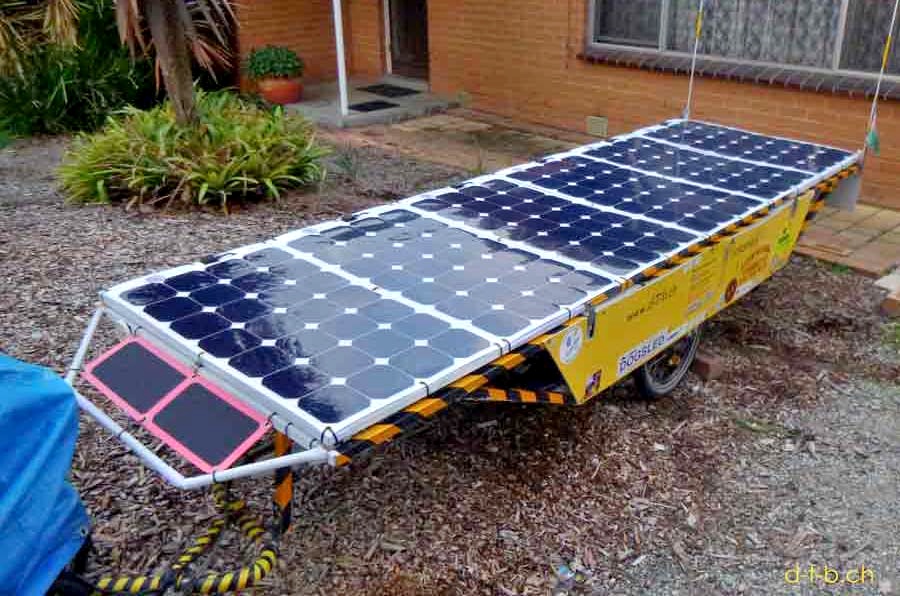
6 pieces of high performance-Solarmodul SolarFun easy SFe 86-15, very light and flexible high performance Solarmodul with SunPower-Cells with approx. 20% efficiency. 960 x 540 x 3mm, weight 1,8kg, 3m wire with ASE-Plug as well as 8 attachment-loops 10mm for versatile possibilities to attach the panels.
Specification per panel:
- Peak Power (STC) (Pmax): 86.0 W
- Open Circuit Voltage/ VOC 18.9 V
- Max. Power Voltage/ Vmp 15.4 V
- Short Circuit Current / Isc 5.97 A
- Max. Power Current/ Imp 5.62 A
- Maximum System Voltage 48V DC
- Sunpower cells, efficiency min. 19.5%
- Output Values Tolerance Range +-7%
- All ratings at standard test conditions (STC)
Measurements: 6x each 96 x 54 cm = 324cm
Peak Power in total: 516Wp at 20° C
Solar regulators
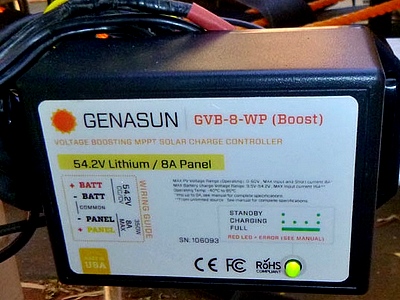
- 2 x Genasun (GVB-8-LI-54.6V)
- 1 x Genasun (GVB-8-WP Boost 105-35W Waterproof)
Supporting structure
On the third trailer, I constructed a suspension and a friend donated two front forks from two of his old bikes to provide a guide for the wheels.
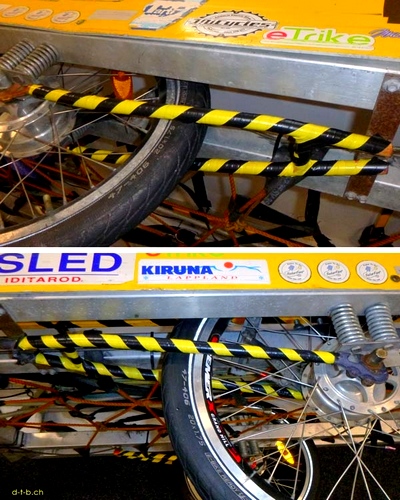
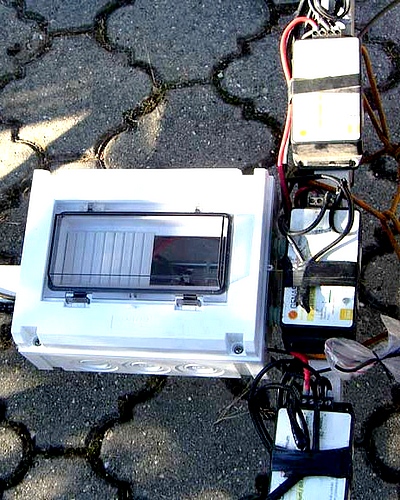
Two solar panels each are connected to one solar charger. The three solar chargers are connected inside of the box and only one cable leads to the battery. The rear light on the trailer is also powered through this box. (Engineered by e-pohony)
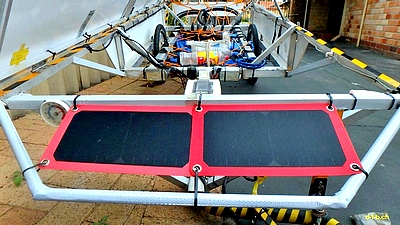
At the front of the trailer, I mounted two small solar panels that recharge my phone and my headlamp during the day. At first, I only had one big one, but it quit powering at some point, so I replaced it with these two that I found in Australia.
As I replaced the Solar panels, I drilled a hole into the plastic to run the cable through. Before I had the cables wrapped around the structures and they got some pull when the space was tight.
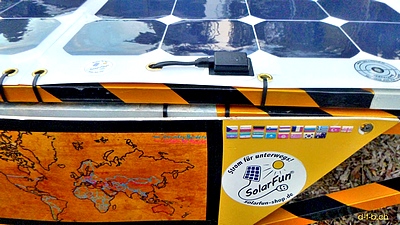
Feedback
So far, I rode the Solatrike 40’000 km from the Czech Republic to New Zealand. In the first test phase of 10 days, I drove from Uherský Brod to Brno and via a detour to Austria back to Uherský Brod for 500 km. On the following trip I filled the remaining 39’500 km. I did everything self-supported and self-organised.
Since July 6th 2015 the Solatrike was on the way on its longer trial route from the Czech Republic through Poland and Eastern Germany to end in the Czech Republic again. Since October 6th 2015 the Solatrike was again on the road from the Czech Republic through Slovakia, Hungary, Romania and Bulgaria to Greece in direction of Athens and further on to Crete and Chios. From there the Solatrike was travelling through Turkey with a short round-trip through Northern Cyprus. After that the Solatrike crossed Georgia, Azerbaijan and Iran. I and the Trike travelled separately by plane to Uzbekistan. There I had to build a new trailer. From Uzbekistan the travel went on through Kazakhstan to Bishkek in Kyrgyzstan.
Here the trip took a break of about 6 months. In May 2017 the travel continued from Kyrgyzstan via Kazakhstan through China from west to east and South Korea from north to south. Unfortunately the travel couldn’t continue neither in Japan nor in South East Asia and so the Solatrike was shipped to Hong Kong. From Hong Kong I wanted go back to China and then further on to Vietnam but that wasn’t possible either. That’s why the Trike was shipped to Darwin in Australia and I dumped the second trailer.
Before I continued, I had to build a new trailer in Darwin. Since June 24. 2018 the Solatrike was on the road in Australia and went from Darwin via Broome to Perth, through the Nullarbor and around the Eyre Peninsula to Adelaide, Melbourne, Canberra and Sydney. From there the Solatrike was shipped to Auckland in New Zealand.
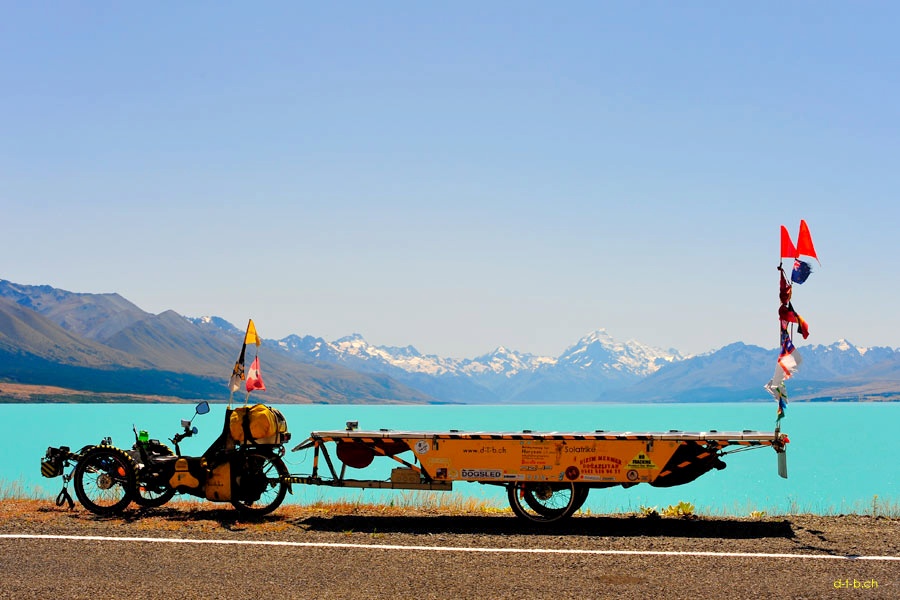
On August 24. 2019 it has set off for Northland loop and was since October 12. 2019 en route across the North Island to Wellington, where it took the ferry to the South Island. From Picton the journey went to Golden Bay and back. Then along the east coast to Christchurch. Then I had still some time and drove via Lake Tekapo, Lake Pukaki and over the Lindis Pass to Invercargill, Bluff and Curio Bay. From where it has been transported back to Christchurch due to electrical system failures and been repaired. Due to COVID-19 Lock down and the closing of the country borders worldwide, the project has been stopped on March 2020 for an unknown period of time.
That’s for the moment at the end of 2022. But I hope when the shipping cost will drop to normal again, that I can ship the Solatrike from New Zealand to Canada and continue my trip… as long and as far as I can (and my money last).
For safety on the roads, I have to say that I am a bit safer with this vehicle than with a full packed bike. This is so extraordinary that the drivers keep a greater distance when overtaking to look at the thing. I was only hit twice and both times at the left corner of the trailer by drivers who first wanted to overtake me and then realized that they should turn right, let themselves fall back and swerved in too early.
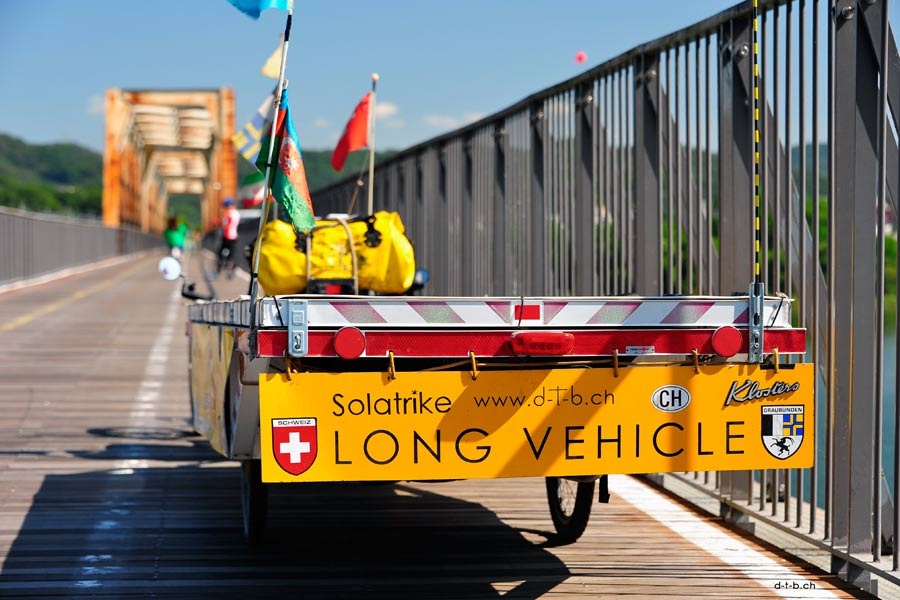
They had a somewhat short memory. Even though it has a sign in the back: “Long vehicle”. Except in Hungary, where a few trucks roared a bit close to me, I always felt safe on the streets. Iranians are the worst drivers I have experienced and sometimes it was very scary. In turn, when I had to cross several lanes, I could just wave my hand and everyone made room for me. I can also tell you about the half-blind guy in New Zealand who drove his SUV into the side of my Solatrike and apparently didn’t see me, or the truck on a makeshift dirt road in China that almost ran me over. But for these five years, these are very few incidents, because the many nice encounters on the roads are countless and priceless.
Strong points
For the fact that I have no idea about electrical engineering, solar energy and long-term cycling, suffer from knee problems and an incurable disease, don’t have an athletic body and am getting quite old, the Solatrike has taken me an amazing distance. Even though I kept improving it during the trip, fixing bugs, replacing the motors and the solar panels, it worked more than well. The choice to go with two motors proved to be a slam dunk. (Thanks, Honza!) The very flat design makes it less vulnerable to strong winds. Another plus is the very simple electrical design since the beginning and so that I also understand it, I simplified it even more. Clever minds at E-pohony replaced my battery after 3000km, changed it from its original place in the trailer and mounted it above the rear wheel. This allows simpler wiring and I can use the trike without the trailer using the motor. I only need to disconnect the power from the solar panels, the brake cable and the clutch to disconnect the trike from the trailer.
Areas for improvement
At the moment, I don’t see anything that could be improved. But the further journey will show what I could improve. I need to replace the Cycle Analyst because the numbers are getting harder to read due to the scratched display.
Tips
Watch the heat: most panels have their peak performance below 25°C (always measured at 20°C). If it gets hotter, the performance will drop. The flexible panels can also bend in high heat if they are not supported enough. This will cause cracks in the cells and permanently damage the current flow.
Humidity and electronics are also a bad mix. I have had the most problems in the fall when humidity is high. You can’t waterproof the battery, but plastic protection is beneficial. Take it indoors or in a tent overnight if possible.
Build your own project according to your wishes, ideas and needs. Do less calculations, but more test drives, because there are too many factors that you cannot calculate at all. For example, the road conditions or your own condition. But the most important thing is: have fun with it!
My next bike/ or next evolutions
There won’t be a next bike. But if I were to start all over again, I would go for a 36V system because you can then use Grin Technologies batteries. These batteries can be shipped by mail, no matter where you are.
